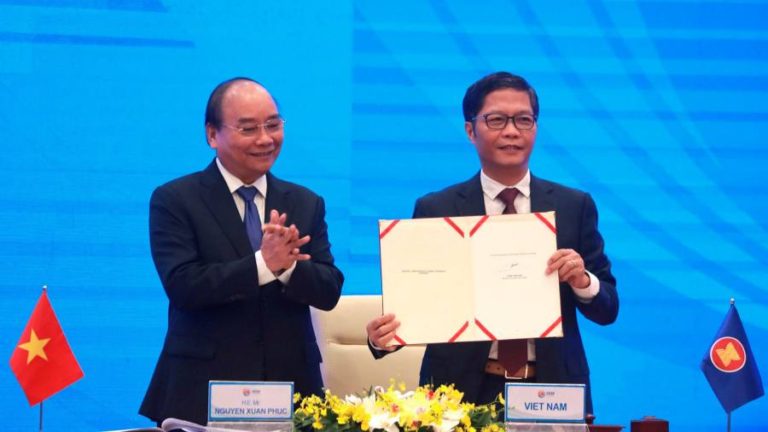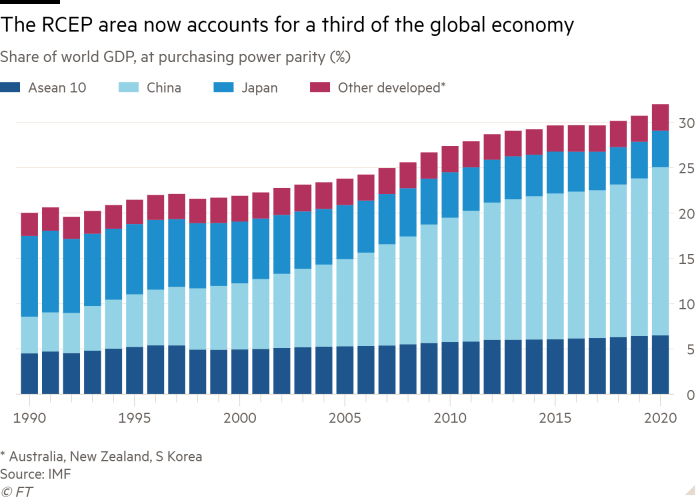
[ad_1]
Leaders from 15 Asia-Pacific nations on Sunday sealed one of the biggest trade deals in history, seeking to reduce barriers in an area covering a third of the world’s population and economic output.
The Regional Comprehensive Economic Partnership — or RCEP — marks a major step forward for economic integration in the region, and follows almost a decade of negotiations.
Economists say it could add almost $200bn annually to the global economy by 2030.
The RCEP takes most of the existing agreements signed by the 10 members of the Association of Southeast Asian Nations — Brunei, Cambodia, Indonesia, Laos, Malaysia, Myanmar, the Philippines, Singapore, Thailand and Vietnam — and combines them into a single multilateral pact with Australia, China, Japan, New Zealand and South Korea.
By combining a mishmash of separate arrangements into a single deal, RCEP brings Asia a step closer to becoming a coherent trading zone like the EU or North America, even if it is not expected to lead to large overall tariff reductions.
China’s premier Li Keqiang described the agreement as “a victory of multilateralism and free trade”, according to a report from the official Xinhua news agency.
Japan and South Korea are expected to be among the biggest winners from the deal, but the benefit of cheaper goods will spread as far as Europe and the US.
“We signed [RCEP] today, after a tough slog of eight years,” said Lee Hsien Loong, Singapore’s prime minister, on Sunday. “This is a major step forward for our region. At a time when multilateralism is losing ground, and global growth is slowing, the RCEP shows Asian countries’ support for open and connected supply chains, freer trade and closer interdependence.”
Analysts said the deal is likely to further diminish US influence in the region after president Donald Trump withdrew from the Trans-Pacific Partnership, another large regional trading pact.
The deal would have been even larger but India withdrew from the talks in 2019 and has so far refused to come back, heightening concerns among some signatories that China will dominate the pact.
Indian businesses had feared a deluge of cheap Chinese imports, and complained the deal would have done little to advance trade in services, an area where India has an advantage.
“By some measures, this is the largest free trade agreement in history,” said Peter Petri, professor of international finance at Brandeis University. “About 30 per cent of the world’s people are covered.”
According to estimates by Prof Petri and Michael Plummer, a professor of international economics at Johns Hopkins University, RCEP will add $186bn to the size of the global economy and 0.2 per cent to the gross domestic product of its members.
“From a global perspective, the RCEP agreement, even if a littler shallower than other ‘mega-deals’, signals that Asia keeps pushing ahead with trade liberalisation even as other regions have become more sceptical,” said Fred Neumann, co-head of Asian economic research at HSBC.
What is in the deal?
The agreement has all the usual chapters of a free trade deal — tariffs, customs administration, sanitary measures, services, investment and others — but two elements are particularly significant.
The first is rules of origin, the criteria that determine where a product was made. All of Asean’s trade agreements have different rules of origin so, for example, if a company in Indonesia makes a bicycle it might be eligible under a free trade deal with Japan but would need different components to be eligible under a deal with South Korea.

RCEP will sweep all of that away. “When you manufacture a product for RCEP it works for all 15 countries. And there’s only one piece of paper that you need,” said Deborah Elms, executive director of the Asian Trade Centre consultancy in Singapore.
The second crucial factor is that it marks the first free trade deal between China, Japan and South Korea. Although RCEP is a fairly shallow agreement, this is still a big step. “RCEP allows them to accomplish something that would have been very difficult politically if they’d done it only among themselves,” said Prof Petri.
What is left out?
Unlike the overlapping Trans-Pacific Partnership trade deal, the RCEP is relatively unambitious, eliminating 90 per cent of tariffs compared with almost 100 per cent in TPP. Agriculture is largely absent and the coverage of services is mixed. RCEP does relatively little to set common standards for products.
“The critical point about RCEP is that the region is enormously diverse. There are big countries and small countries, rich countries and poor countries,” said Prof Petri. “The rules have essentially accommodated all of these diverging interests.”
Ms Elms said the ecommerce chapter was a particular disappointment. The 15 countries were unable to agree any rules on cross-border data flows or a customs moratorium on data transmission.
The biggest absence, however, is India. As a huge economy with relatively few free trade agreements, Indian participation could have led to a dramatic increase in commerce. But New Delhi feared its manufacturers would be swamped by cheap Chinese competition.
Nonetheless, the agreement is expected to include provisions should India choose to join.
What does it mean for China and the US?
A common criticism of RCEP is the dominant size of China within it — a fear that became much stronger when India pulled out. The deal gives China an important voice in setting standards for regional trade and if Beijing uses that power collaboratively, its soft power will grow. “It’s potentially very good for China,” said Prof Petri.
Ms Elms said China’s sheer scale would make it an important player within the deal. “RCEP has never been China-led or China-driven. This was Asean’s agreement,” she said. “But once the agreement takes effect it will be hard for Asean to stay in the driver’s seat.”
The US now sits outside both the main trading groups in Asia after Mr Trump withdrew from the TPP. That means neither the EU nor the US — the world’s traditional trade superpowers — will have any voice when Asia sets its trading rules.
What happens next?
It will take some time to ratify RCEP and even longer for some of the tariff provisions to come into effect. But RCEP is likely to shape the future of trade in Asia. “Asean agreements can be improved over time,” said Prof Petri. “The process is often slow but this is not the end.”
Now that they have done it in the context of RCEP, one of the most significant effects may be to accelerate talks on a China-Japan-South Korea free trade agreement. Given all three are manufacturing and technology powerhouses, that would be a big development for global commerce.
But the greatest consequence may be taking the first step towards Asia’s emergence as a coherent trading zone, like Europe or North America. “Asia is integrated but it’s for the purpose of delivering goods to other markets,” said Ms Elms. “RCEP changes that.”
[ad_2]
Source link